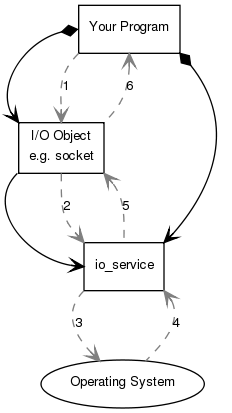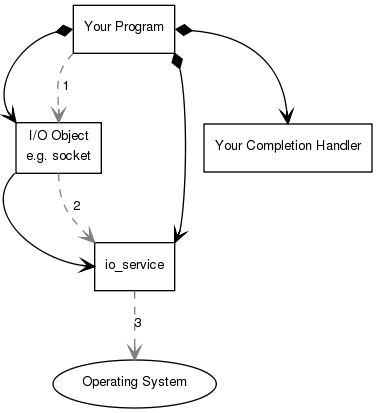Basic Boost.Asio Anatomy
Boost.Asio基础剖析
Boost.Asio may be used to perform both synchronous and asynchronous operations on I/O objects such as sockets. Before using Boost.Asio it may be useful to get a conceptual picture of the various parts of Boost.Asio, your program, and how they work together.
Boost.Asio可用于在诸如socket对象上执行同步和异步操作。在使用Boost.Asio之前,了解一下Boost.Asio和你的程序的各个部分的概念图,以及它们如何一起工作,是非常有用的,
As an introductory example, let's consider what happens when you perform a connect operation on a socket. We shall start by examining synchronous operations.
作为一个入门例子,让我们了解一下,当你在执行一个socket连接时,发生了什么情况。这里我们将开始研究同步操作。

Your program will have at least one io_service object. The io_service represents your program's link to the operating system's I/O services.
你的程序将至少有一个 io_service 对象,这个 io_service代表了你的程序到操作系统的
I/O服务的连接。
boost::asio::io_service io_service;
To perform I/O operations your program will need an I/O object such as a TCP socket:
为了执行I/O操作,你的程序需要一个 I/O对象,如TCP socket:。
boost::asio::ip::tcp::socket socket(io_service);
When a synchronous connect operation is performed, the following sequence of events occurs:
当异步连接操作执行时,下列事件顺次发生:
1. Your program initiates the connect operation by calling the I/O object:
你的程序通过调用 I/O对象初始化连接操作,
socket.connect(server_endpoint);
2. The I/O object forwards the request to the io_service.
I/O转发请求到io_service.
3. The io_service calls on the operating system to perform the connect operation.
io_service调用操作系统执行连接操作
4. The operating system returns the result of the operation to the io_service.
操作系统返回操作结果给 io_service
5. The io_service translates any error resulting from the operation into a boost::system::error_code. An error_code may be compared with specific values, or tested as a boolean (where a false result means that no error occurred). The result is then forwarded back up to the I/O object.
io_service将任何错误代码转换为boost::system::error_code,这个error_code可以和特定值比较,也可作为boolean测试(false表示没有错误发生)。结果然后转发回 I/O对象
6. The I/O object throws an exception of type boost::system::system_error if the operation failed. If the code to initiate the operation had instead been written as:
如果操作失败, I/O对象抛出boost::system::system_error类型的异常。如果初始化操作的代码按下面的方式书写:
boost::system::error_code ec;
socket.connect(server_endpoint, ec);
then the error_code variable ec would be set to the result of the operation, and no exception would be thrown.
那么 error_code 变量 ec将被设置为操作的结果,并且没有异常抛出。
When an asynchronous operation is used, a different sequence of events occurs.
当使用异步操作时,将是不同的事件产生顺序

1. Your program initiates the connect operation by calling the I/O object:
你的程序通过调用I/O对象初始化连接操作
socket.async_connect(server_endpoint, your_completion_handler);
where your_completion_handler is a function or function object with the signature:
这里your_completion_handler是一个带有signature (目标识别特征)的函数或函数对象:
void your_completion_handler(const boost::system::error_code& ec);
The exact signature required depends on the asynchronous operation being performed. The reference documentation indicates the appropriate form for each operation.
确切的signature (目标识别特征)根据执行的异步操作的不同而不同,参考文档为每个操作列出了正确的形式。
2. The I/O object forwards the request to the io_service.
I/O对象将请求转发给io_service
3. The io_service signals to the operating system that it should start an asynchronous connect.
io_service通知操作系统,告诉操作系统启动一个异步连接
Time passes. (In the synchronous case this wait would have been contained entirely within the duration of the connect operation.)
过一段时间。(在同步操作的情况下,这个等待是整个连接操作的时间)

4. The operating system indicates that the connect operation has completed by placing the result on a queue, ready to be picked up by the io_service.
操作系统通过在队列里放置一个结果来指示连接操作已经完成,这个结果等待io_service来取。
5. Your program must make a call to io_service::run() (or to one of the similar io_service member functions) in order for the result to be retrieved. A call toio_service::run() blocks while there are unfinished asynchronous operations, so you would typically call it as soon as you have started your first asynchronous operation.
为了确保结果能够被收到,你的程序必须调用io_service::run()(或相似的io_service成员函数)。当有未完成的操作时,io_service::run()的调用被阻塞,所以你要在第一次启动异步操作后尽快调用io_service::run()。
6. While inside the call to io_service::run(), the io_service dequeues the result of the operation, translates it into an error_code, and then passes it to your completion handler.
在io_service::run()内部, io_service 从队列移除操作结果,转换为 error_code,并传递给your completion handler





















 3874
3874

 被折叠的 条评论
为什么被折叠?
被折叠的 条评论
为什么被折叠?








